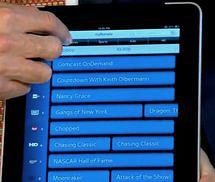Cable Show: IP Enthusiasm, 3D Wonder, Regulatory Caution
LOS ANGELES: Brian Roberts could get a job demonstrating and selling high-tech equipment in an electronics store, based on his video spiel showing off a Comcast remote control app for the iPad. Comcast’s CEO interrupted his comments during a senior executives’ session at the National Cable TV Association convention to run the video in which he uses a Comcast iPad app to go through a cable program menu, including thousands of on-demand shows, digital recording options and social networking connections.

Xfinity remote demo. Photo courtesy Multichannel News “This is going to work on almost every box that has been deployed,” Roberts said, pointing out that all services were being controlled from the cable headend using a variety of technologies, including Internet Protocol. Roberts’ demo and comments were part of a larger message that permeated the Cable Show: despite the industry’s recent investment in switched video and other transmission technologies, its future lies in IP. A major challenge is how to manage the migration.
Not everyone is ready to make that IP plunge. Although multiplatform distribution permeated the convention agenda—with many cable operators and especially program networks accelerating their efforts—there were also constant reminders about balancing the relatively new DOCSIS 3.0 technology with IP distribution.
With an unexpected turnout of 13,000 people (about 1,000 more than predicted), the Cable Show had a vitality despite the paucity of technology or programming breakthroughs, or even any big sales announcements.
Predictably, policy issues—especially network neutrality and retransmission consent—were on the minds of many attendees. FCC Chairman Julius Genachowski, in his Thursday remarks, repeated assurances he has made in recent months that the FCC will evaluate issues. At a news conference following his remarks, Genachowski said that the FCC’s examination of retrans consent will focus on how the “framework is… affecting consumers” to find out if the current approach “is still the right framework.
On a different topic, during his convention appearance, Genachowski insisted that, “Rate regulation is off the table. We’re going to rely on competition.”
3DTV demonstrations peppered the exhibit show floor, many of them similar to ones seen earlier this year at CES and NAB exhibits. But opinions about it were mixed. Viacom CEO Philippe Dauman said 3D “has been fantastic,” but cautioned that it will take “a few years for it to become meaningful in the TV industry.” Time Warner Cable CEO Glenn Britt said, “We have to pay attention to consumers’ (interests),” noting that high definition TV “was around for 20 years before it took off” in the middle of the last decade.
Tivo CEO Tom Rogers responded to a comment from a Fox executive on an earlier panel about “storytelling.” The Fox executive had suggested that the hit film “Avatar” succeeded because of the compelling storyline, not just because it was in 3D. Rogers opined that such a comment was akin to people who said Raquel Welch was a great star because she was so “well spoken.”
Interactive TV—especially customized advertising—ascended, as more services emerged using the EBIF (Enhanced TV Binary Interchange Format). A consortium of companies agreed to use a “SelecTV” icon (a red oval with that term in it) as a consistent reminder to viewers that iTV content is available. Canoe Ventures, the industry’s advertising collaboration, will manage the SelecTV brand and license it to certified cable providers, programmers and advertisers.
For more coverage on Cable Show 2010, visit Multichannel News.
Get the TV Tech Newsletter
The professional video industry's #1 source for news, trends and product and tech information. Sign up below.
Gary Arlen, a contributor to Broadcasting & Cable, NextTV and TV Tech, is known for his visionary insights into the convergence of media + telecom + content + technology. His perspectives on public/tech policy, marketing and audience measurement have added to the value of his research and analyses of emerging interactive and broadband services. Gary was founder/editor/publisher of Interactivity Report, TeleServices Report and other influential newsletters; he was the long-time “curmudgeon” columnist for Multichannel News as well as a regular contributor to AdMap, Washington Technology and Telecommunications Reports; Gary writes regularly about trends and media/marketing for the Consumer Technology Association's i3 magazine plus several blogs.

